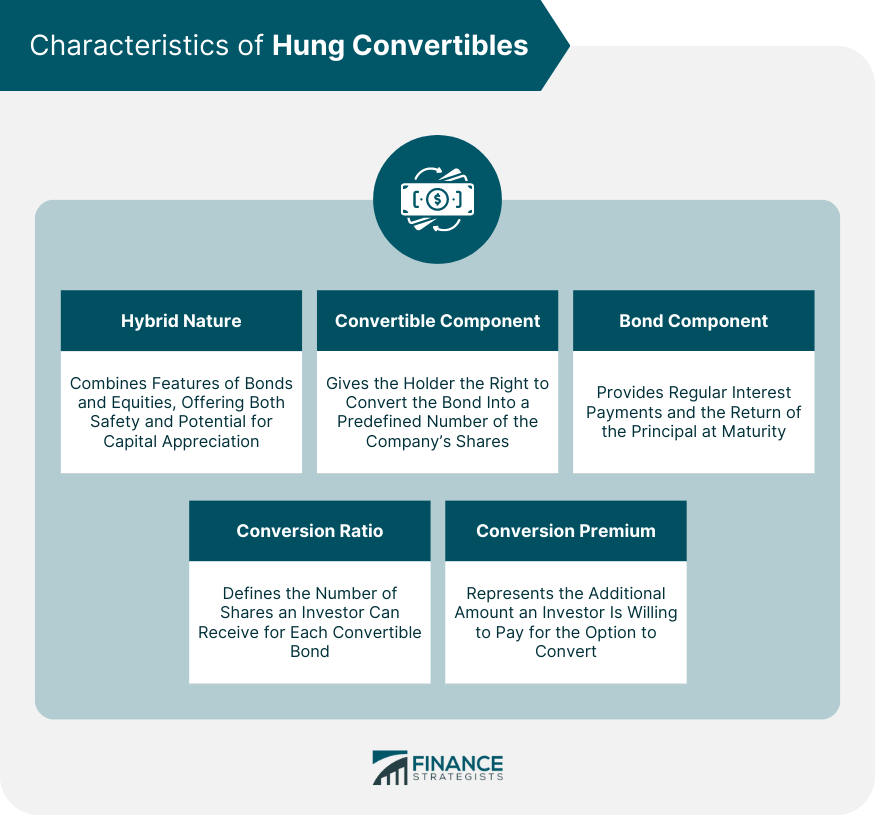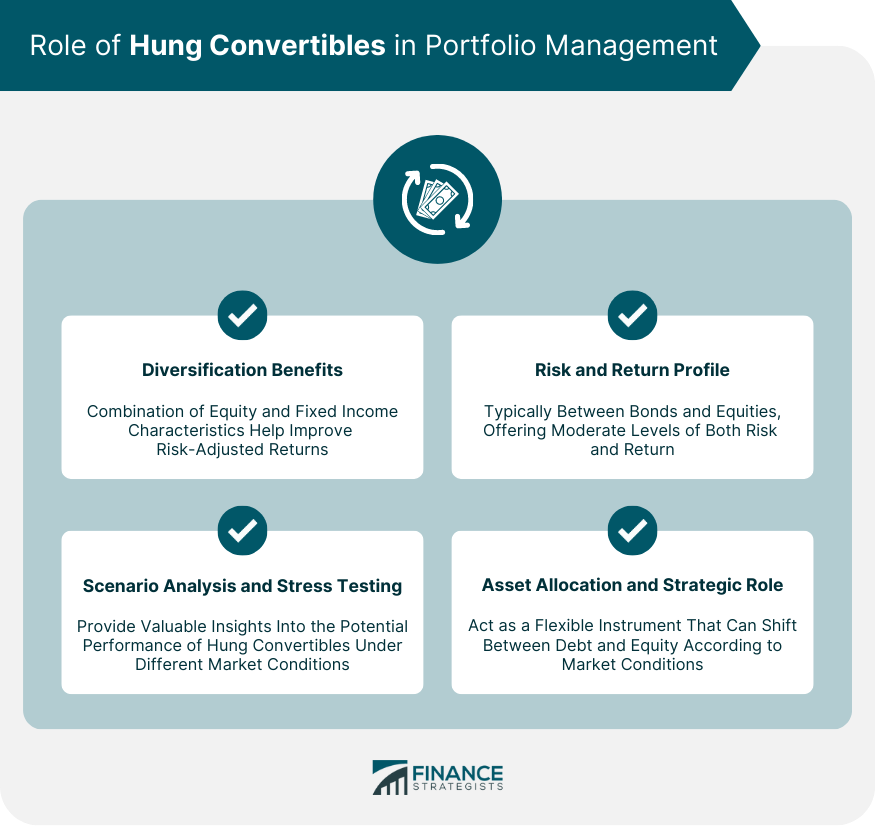Hung convertibles refer to convertible bonds that are trading in the market at a price below their intrinsic value. This typically occurs when the underlying stock price drops significantly, rendering the conversion feature less attractive. Convertible bonds, in essence, are debt instruments that can be converted into a predetermined amount of the issuer's equity. Hung convertibles pose a unique situation, as they provide potential opportunities for arbitrage. Understanding hung convertibles is essential for effective portfolio management. The concept plays a significant role in convertible arbitrage strategies, where traders aim to exploit price discrepancies between the convertible bond and its underlying stock. Additionally, hung convertibles offer insights into the health of the issuing company and the broader market conditions. Knowledge of hung convertibles can thus influence investment decisions, risk management, and strategic financial planning. Hung convertibles, like all convertible securities, are hybrid instruments combining features of bonds and equities. They provide the safety and regular income of bonds and the potential for capital appreciation of equities, an appealing combination for investors seeking diversification. The convertible component of a hung convertible offers the holder the right, but not the obligation, to convert the bond into a predefined number of the company's shares. This attribute provides upside potential if the company’s share price rises. The bond component provides regular interest payments (coupon) and the return of the principal at maturity, just like a traditional bond. It offers downside protection if the company’s share price falls. The conversion ratio is the number of shares an investor can receive for each convertible bond. It is usually defined at the time of issue and determines the conversion price. The conversion premium is the percentage by which the price of the convertible bond exceeds the current market value of the common stock into which it can be converted. It represents the additional amount an investor is willing to pay for the option to convert. A hung convertible remains unconverted despite the stock price being above the conversion price. It hangs in the balance between its dual identities, with neither the bond nor the equity component fully dominating. A convertible can become hung due to a variety of reasons. Sometimes, it may be due to the strategic decisions of the bondholders, or it may occur when market volatility and pricing inefficiencies prevent profitable conversion. The pricing of hung convertibles can be challenging due to their hybrid nature. Both equity and fixed-income valuation models must be used, incorporating factors such as interest rates, the company's credit quality, and the volatility of the underlying equity. Investors holding hung convertibles essentially hold an option that remains unexercised. It means they continue to benefit from bond-like features such as regular coupons while keeping the upside potential should the equity price continue to rise. Hung convertibles can play a significant role in portfolio management due to their ability to provide diversification benefits. Their unique combination of equity and fixed income characteristics can help improve risk-adjusted returns. The risk and return profile of hung convertibles is typically between that of bonds and equities, offering moderate levels of both risk and return. However, the specific risk-return profile can vary based on the terms of the convertible and market conditions. In portfolio management, scenario analysis and stress testing can provide valuable insights into the potential performance of hung convertibles under different market conditions. These tools can help investors understand the risks associated with these instruments and prepare accordingly. In terms of asset allocation, hung convertibles can act as a flexible instrument that can shift between debt and equity according to market conditions. They can play a strategic role in a portfolio, helping to manage risk and potentially enhance returns. Interest rates have a significant impact on hung convertibles. When interest rates rise, the bond value of the convertible decreases, potentially pushing the security to a more equity-like state. High stock market volatility can influence the convertible's equity component. Increased volatility can make the option to convert more valuable, possibly leading to a greater likelihood of convertibles becoming hung. Other economic factors, such as corporate earnings, credit spreads, and regulatory changes, can also affect the behavior and performance of hung convertibles. These need to be considered in any comprehensive analysis of these securities. Like all securities, issuers and investors in hung convertibles must comply with various disclosure and compliance requirements. These include providing accurate and timely information about the security's terms and the issuer's financial condition. The tax treatment of hung convertibles can be complex and depends on various factors, such as the jurisdiction, the holder's tax status, and the specific terms of the convertible. Investors should consult with a tax advisor before investing in these securities. For cross-border transactions involving hung convertibles, investors must consider various jurisdictional issues, such as different regulatory requirements, tax laws, and accounting standards. These factors can significantly influence the attractiveness and profitability of such investments. The world of convertible securities has witnessed significant evolution and innovation. New structures and features are constantly being introduced, enhancing the flexibility and appeal of these instruments. Technological advancements have brought about changes in how hung convertibles and other securities are traded and managed. Digital platforms have made market access easier, while sophisticated analytical tools have improved the ability to model and manage these complex securities. The market for hung convertibles is expected to grow, driven by increasing investor demand for hybrid securities that offer both safety and upside potential. However, the future will also bring challenges, such as regulatory changes and market volatility. Hung convertibles are an intricate financial instrument that bridges the gap between bonds and equities, providing both stability and potential for growth. With their dual nature, they offer intriguing opportunities for arbitrage and can provide diversification benefits for portfolio management. These securities 'hang' between being profitable as a bond or equity, creating a distinctive scenario for investors. As an asset, they exhibit an adaptive response to shifting market conditions influenced by interest rates, stock market volatility, and various economic factors. Legal and regulatory aspects add another layer of complexity, with cross-border transactions demanding special consideration. With continuous innovation and the influence of technology, hung convertibles are poised to remain significant in the evolving landscape of securities trading. Understanding these unique assets can guide investment decisions, enhance risk management, and open new pathways for potential return.What Are Hung Convertibles?
Characteristics of Hung Convertibles
Hybrid Nature of the Instrument
Convertible Component
Bond Component
Conversion Ratio
Conversion Premium

Working With Hung Convertibles
Explanation of 'Hung' Status
Circumstances Leading to Convertibles Becoming 'Hung'
Pricing and Valuation of Hung Convertibles
Implications of Being 'Hung' for Investors
Role of Hung Convertibles in Portfolio Management
Diversification Benefits
Risk and Return Profile
Scenario Analysis and Stress Testing
Asset Allocation and Strategic Role

Impact of Market Conditions on Hung Convertibles
Interest Rate Environment and Its Effect
Stock Market Volatility and Its Impact
General Economic Factors and Considerations
Legal and Regulatory Aspects of Hung Convertibles
Disclosure and Compliance Requirements
Tax Implications
Cross-Border Transactions and Jurisdictional Issues
Recent Developments and Trends in Hung Convertibles
Evolution and Innovation in Convertible Securities
Impact of Technological Advancements
Market Trends and Future Outlook
Final Thoughts
Hung Convertibles FAQs
Hung convertibles are convertible bonds that have not been converted into equity despite the share price surpassing the conversion price. They are unique in the sense that they 'hang' between their bond and equity states, providing the benefits of both types of instruments.
Hung convertibles have a hybrid nature, combining features of bonds and equities. They offer regular interest payments (coupon) and return the principal at maturity, like a traditional bond, while providing the potential for capital appreciation if the company’s share price rises, like equities. Key elements include the conversion ratio and the conversion premium.
The market environment, particularly interest rates and stock market volatility, plays a significant role in the behavior of hung convertibles. Rising interest rates can decrease the bond value of the convertible, while high market volatility can make the option to convert more valuable.
Investors in hung convertibles need to adhere to various disclosure and compliance requirements. Also, the tax implications of investing in hung convertibles can be complex and depend on various factors such as the jurisdiction and the holder's tax status. For cross-border transactions, differing regulatory requirements and tax laws need to be considered.
The future outlook for hung convertibles is positive, with increasing investor demand for hybrid securities that offer both safety and upside potential. The evolution and innovation in convertible securities, driven by technological advancements, are expected to further enhance the attractiveness of these instruments. However, potential challenges include regulatory changes and market volatility.
True Tamplin is a published author, public speaker, CEO of UpDigital, and founder of Finance Strategists.
True is a Certified Educator in Personal Finance (CEPF®), author of The Handy Financial Ratios Guide, a member of the Society for Advancing Business Editing and Writing, contributes to his financial education site, Finance Strategists, and has spoken to various financial communities such as the CFA Institute, as well as university students like his Alma mater, Biola University, where he received a bachelor of science in business and data analytics.
To learn more about True, visit his personal website or view his author profiles on Amazon, Nasdaq and Forbes.















